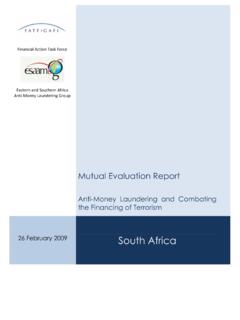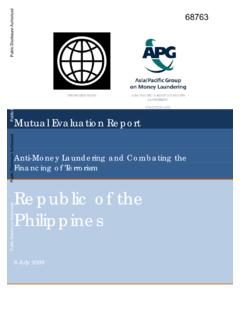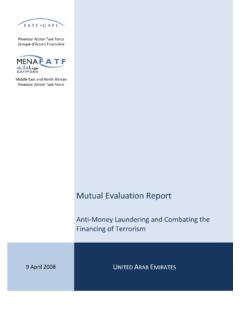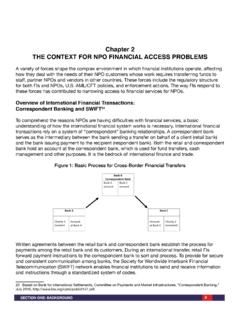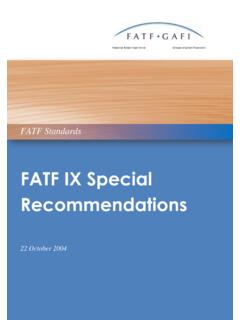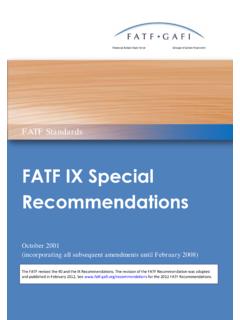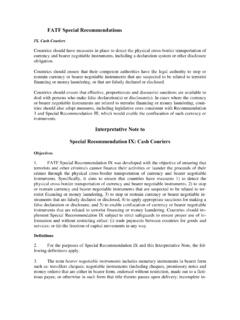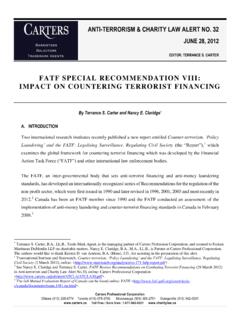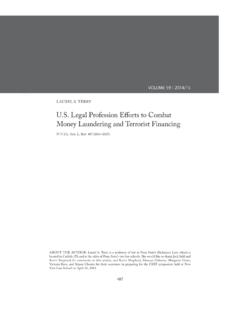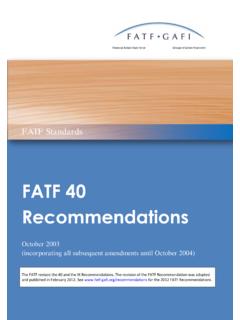Transcription of Financial Action Task Force on Money Laundering Groupe d ...
1 Financial Action Task Force on Money Laundering Groupe d' Action financi re sur le blanchiment de capitaux Methodology for Assessing Compliance with the fatf 40 recommendations and the fatf 9 Special recommendations 27 February 2004. (Updated as of 14 October 2005). 2005 fatf /OECD. All rights reserved. No reproduction or translation of this publication may be made without prior written permission. Applications for such permission should be made to: fatf Secretariat, 2 rue Andr Pascal 75775 Paris Cedex 16, France Fax 33-1-45241760 or TABLE OF CONTENTS. 1. THE AML/CFT ASSESSMENT METHODOLOGY .. 1. BACKGROUND TO METHODOLOGY.
2 1. EVALUATIONS/ASSESSMENTS USING THE METHODOLOGY .. 1. STRUCTURE NECESSARY FOR AN EFFECTIVE AML/CFT SYSTEM .. 2. GUIDANCE ON THE ESSENTIAL CRITERIA, THE ADDITIONAL ELEMENTS, AND THE. COMPLIANCE RATINGS, AND GENERAL INTERPRETATION CONCERNING THE AML/CFT. STANDARDS AND 3. GENERAL INTERPRETATION AND GUIDANCE .. 4. THE FORTY 7. A. LEGAL 7. Scope of the Criminal Offence of Money 7. Recommendation 1 .. 7. Recommendation 2 .. 9. Provisional Measures and Confiscation ..10. Recommendation 3 ..10. B. MEASURES TO BE TAKEN BY Financial INSTITUTIONS AND NON- Financial BUSINESSES AND. PROFESSIONS TO PREVENT Money Laundering AND TERRORIST FINANCING.
3 11. Recommendation 4 ..11. Customer Due Diligence and Recommendation 5 ..12. Recommendation 6 ..17. Recommendation 7 ..18. Recommendation 8 ..19. Recommendation 9 ..20. Recommendation 10 ..21. Recommendation 11 ..22. Recommendation 12 ..23. Reporting of Suspicious Transactions and Compliance ..25. Recommendation 13 ..25. Recommendation 14 ..26. Recommendation 15 ..27. Recommendation 16 ..28. Other Measures to Deter Money Laundering and Terrorist Recommendation 17 ..30. Recommendation 18 ..31. Recommendation 19 ..32. Recommendation 20 ..33. Recommendation 21 ..34. Recommendation 22 ..35. Recommendation 23 ..36.
4 Recommendation 24 ..37. Recommendation 25 ..38. AND OTHER MEASURES NECESSARY IN SYSTEMS FOR COMBATING Money . Laundering AND TERRORIST Competent Authorities, their Powers and Recommendation 26 ..39. Recommendation 27 ..40. Recommendation 28 ..41. Recommendation 29 ..42. Recommendation 30 ..43. Recommendation 31 ..44. Recommendation 32 ..45. Recommendation 33 ..47. Recommendation 34 ..49. D. INTERNATIONAL Recommendation 35 ..51. Recommendation 36 ..52. Recommendation 37 ..54. Recommendation 38 ..55. Recommendation 39 ..56. Recommendation 40 ..57. NINE SPECIAL ESSENTIAL CRITERIA AND ADDITIONAL ELEMENTS ..59. Special Recommendation I.
5 59. Special Recommendation Special Recommendation III ..61. Special Recommendation IV ..64. Special Recommendation Special Recommendation VI ..66. Special Recommendation Special Recommendation Special Recommendation IX ..71. ANNEX GLOSSARY OF DEFINITIONS USED IN THE ANNEX ENDORSEMENT OF THE AML/CFT METHODOLOGY METHODOLOGY FOR ASSESSING COMPLIANCE WITH THE fatf 40. recommendations AND THE fatf 9 SPECIAL recommendations . ANTI- Money Laundering /COMBATING TERRORIST FINANCING. METHODOLOGY 2004 (UPDATED AS OF FEBRUARY 2005). Introduction This document consists of three sections. Following this introduction, the first section consists of an overview of the assessment methodology, its background, how it will be used in evaluations/assessments, and a description of what is necessary for an effective anti- Money Laundering and combating the financing of terrorism ( AML/CFT ) system.
6 The second section contains guidance and interpretation concerning the Methodology, including on the essential criteria, the additional elements and on compliance. The third section sets out the essential criteria and the additional elements for each of the fatf recommendations . Finally, there is annex to the Methodology that sets out definitions or meanings for many of the words or phrases that are used in the document. The AML/CFT Assessment Methodology Background to Methodology 1. The Anti- Money Laundering /Combating Terrorist Financing (AML/CFT) Methodology 2004, including the assessment criteria, is designed to guide the assessment of a country's compliance with the international AML/CFT standards as contained in the fatf Forty recommendations 2003 (updated as of October 2004) and the fatf Nine Special recommendations on Terrorist Financing 2001 (updated as of October 2004) (referred to jointly as the fatf recommendations ).
7 The criteria within this Methodology do not expand upon or modify the Forty recommendations and Nine recommendations which constitute the international standard. The Methodology is a key tool to assist assessors when they are preparing AML/CFT detailed assessment reports/mutual evaluation reports. It will assist them in identifying the systems and mechanisms developed by countries with diverse legal, regulatory and Financial frameworks, in order to implement robust AML/CFT systems. The Methodology is also useful for countries that are reviewing their own systems, including in relation to technical assistance projects.
8 2. It reflects the principles set out in the fatf recommendations . It is also informed by the experience of the fatf and the fatf -style regional bodies (FSRBs) from their mutual evaluations, of the International Monetary Fund (the Fund) and the World Bank (the Bank) in the Financial Sector Assessment Program and by the Fund from the Offshore Financial Center assessment program. The fatf , the Fund and the Bank have also reviewed the assessments/mutual evaluations conducted in 2002. and 2003 using the AML/CFT Methodology issued in October 2002, and these reviews have also provided guidance in developing this Methodology.
9 Evaluations/assessments using the Methodology 3. The Methodology follows the structure of the fatf recommendations . However, as the Methodology is a tool to assist assessors in determining whether countries are in compliance with the fatf recommendations , it is not intended that detailed assessment reports/mutual evaluation reports will rigidly follow the format and structure of the Methodology. Rather the format for these reports will be based on the four fundamental areas noted in paragraph 6 below. 4. The assessments will also need to be based on and refer to relevant underlying information, such as the quantum and type of predicate offences for Money Laundering ; the vulnerability of the country to Money Laundering or terrorist financing, the methods, techniques and trends used to launder Money or fund terrorists; the structure of the Financial system and the nature of the sectors dealing with designated non- Financial businesses and professions; the nature of the underlying criminal justice system, as well as any changes that have been made to the AML/CFT system in the relevant period.
10 Most importantly, the reports will allow for an assessment of whether the recommendations have been fully and properly implemented and the AML/CFT system is effective. As in previous fatf evaluation rounds, this could be judged by reference to quantitative data and the results that have been achieved, or could be based upon more qualitative factors. 5. It should be noted that in some countries, AML/CFT issues are matters that are addressed not just at the level of the national government, but also at state/province or local levels. For example, profit generating criminal offences may exist at both federal and state levels.



